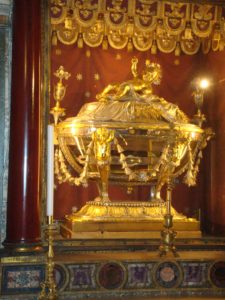It’s from from the German “putzen”, to decorate; it refers to the Moravian crèche scene, a central part of the Christmas season to those religious immigrants who were so influential in the shaping of the holiday in the United States. Like the Latin American and Italian Nativity scenes they can be quite ornate, often occupying a whole room and taking weeks to build; most however are small enough to place under a single Christmas tree. They can portray not only the Holy Family in the stable at Bethlehem but also a whole landscaped area with fences, buildings, foliage and tiny characters.
A similar custom of an under-the-tree crèche is found in northwestern Nova Scotia, Canada where folk artists were famous for the miniature towns, farms and churches that once were placed at the base of the Christmas tree.




